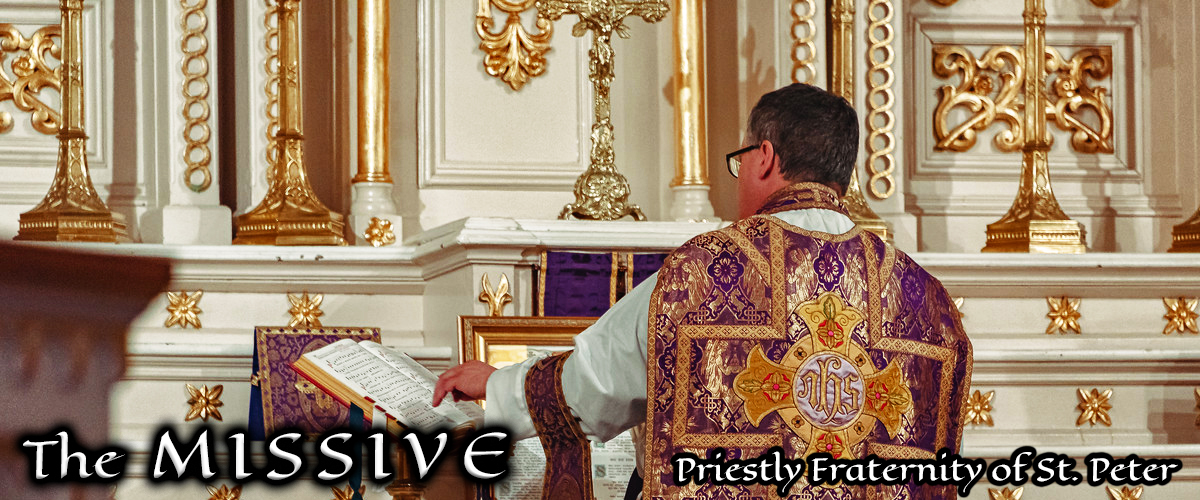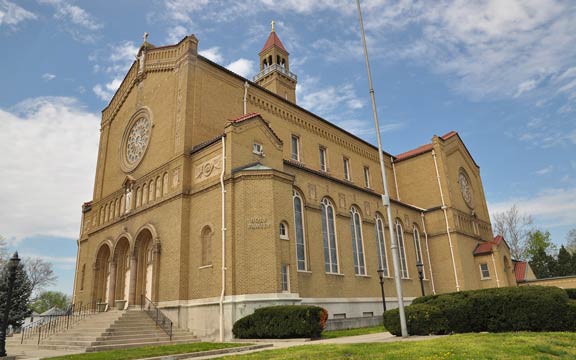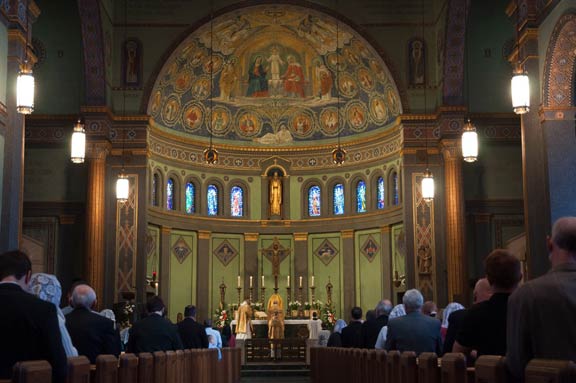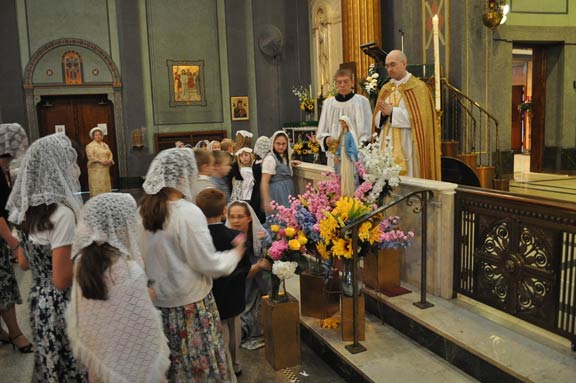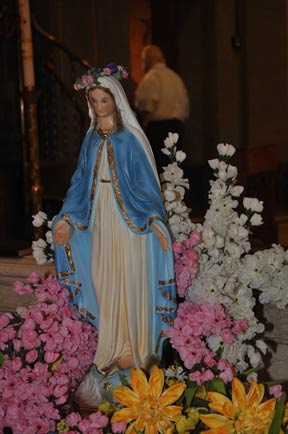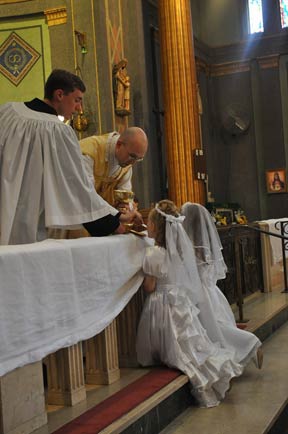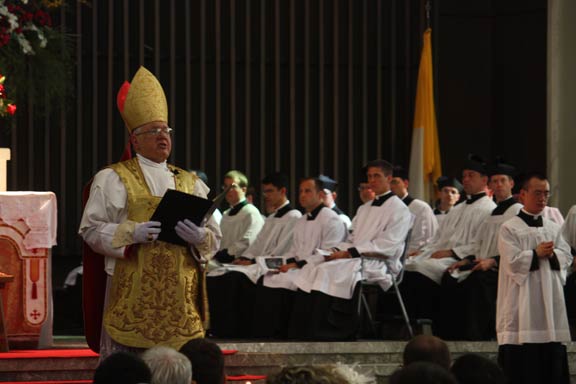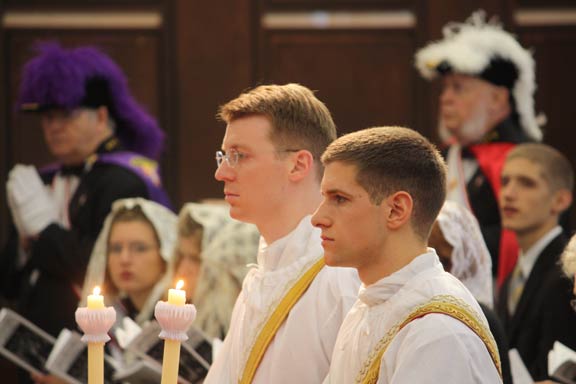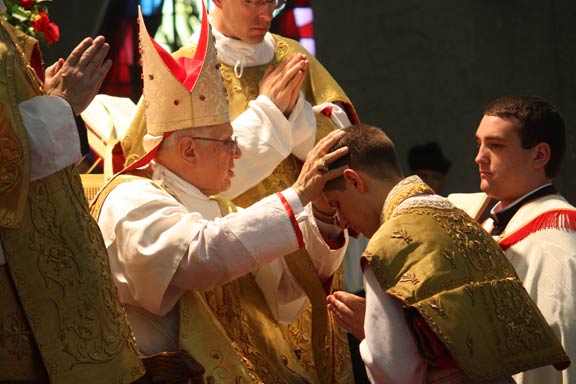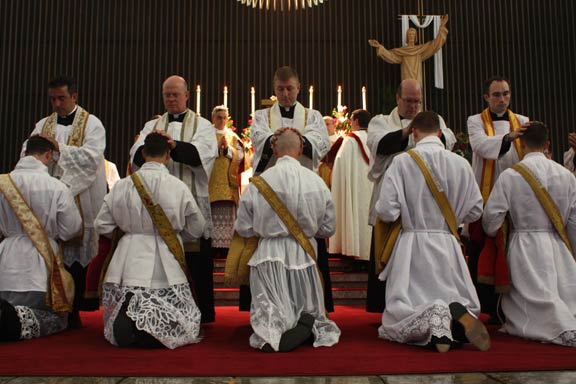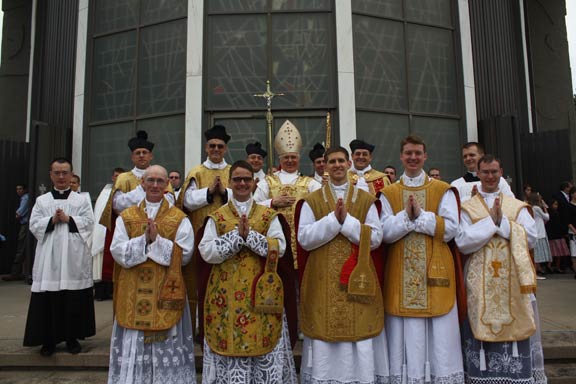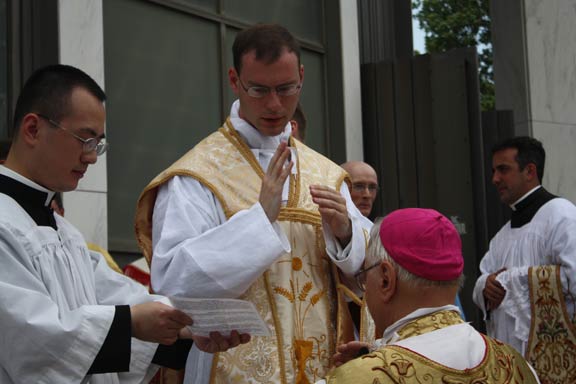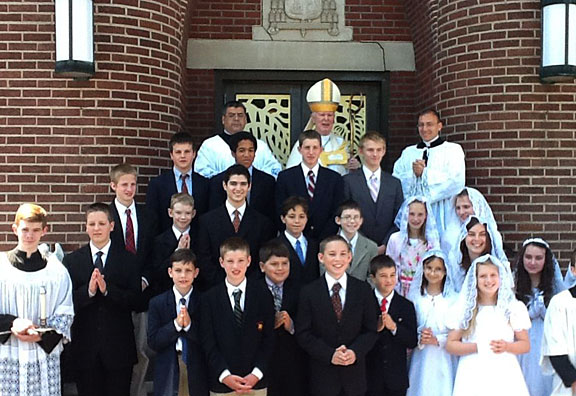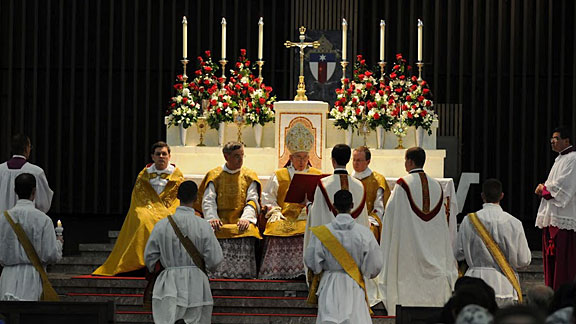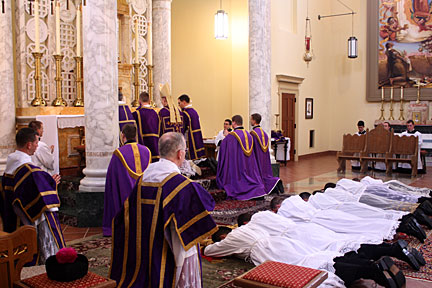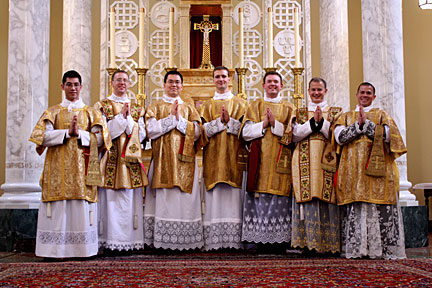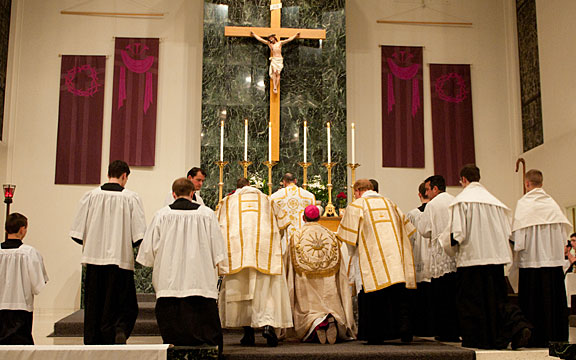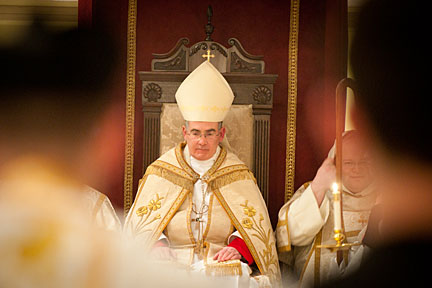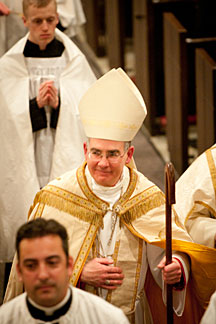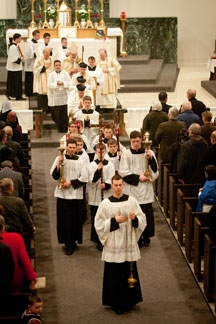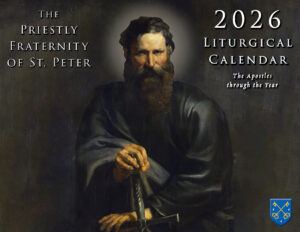May Events at Holy Family in Dayton: First Communion and the May Crowning
The month of May is always a busy time of the year in Catholic parishes throughout the Church with devotions to Our Lady, First Communion and Confirmations. Holy Family, our apostolate parish in Dayton, OH, is no exception. Here are some pictures from the Archdiocese of Cincinnati apostolate for the May Crowning and this year’s First Communicants.
May 29, 2012

Priestly Ordinations 2012: Bishop Bruskewitz Ordains Five
On Saturday, May 19, 2012, five deacons of the Fraternity of St. Peter were raised to the Sacred Priesthood of Christ by His Excellency, Bishop Fabian W. Bruskewitz, at the Cathedral of the Risen Christ in Lincoln, Nebraska.
Our gratitude and thanks to His Excellency for ordaining these men to the Holy Priesthood, our congratulations to our new priests and their families, and thanks to all our benefactors and friends who have supported these men and the seminary during the course of their studies with prayers and other assistance. As each new priest has asked, and we always recommend, continue to pray for our new priests, and all of the priests of the Fraternity.
The newly ordained priests of the Fraternity are:
- Father Gregory Eichman
- Father Kevin O’Neill
- Father Brian McDonnell
- Father Karl Marsolle
- Father Kenneth Walker
Please look for an article and even more photographs of the ordinations in an upcoming edition of the monthly newsletter.
May 21, 2012

Most Reverend James Timlin Confirms Twenty-one at Saint Michael’s in Scranton
On a lovely sunny morning the Most Reverend James Timlin, Bishop Emeritus of the Diocese of Scranton, conferred the sacrament of Confirmation on 15 young men and 6 young women at Saint Michael’s Catholic Church in Scranton. Assisting the Bishop were Fr. Jose Zepeda FSSP, pastor of Saint Michael’s, and Fr. Gregory Pendergraft FSSP, Director of Development for the Fraternity and former pastor of Saint Michael’s.
In his opening words, Bishop Timlin stressed the need to actively cultivate one’s spiritual life and relationship with God in our daily lives, as young men and women grow older and venture on their own into the world. He also stressed the need to have recourse to the Sacrament of Penance and trust in the unfailing forgiveness of God, Who is always here and always ready to strengthen our faith in Him and forgive our transgressions. In addition he gave wise counsel on availing ourselves of the graces of the Holy Ghost, reinforcing the need to be aware in our daily lives of these gifts: wisdom, understanding, knowledge, counsel, fortitude, piety, and fear of the Lord.
Families of the confirmands gave thanks to God for the increase in spiritual strength Confirmation brings, and following the Rite of Confirmation before a full church, a reception was held in the parish hall. The FSSP gives its warmest thanks and prayers for Bishop Timlin, the generous and long time supporter of the FSSP in North America.
May 18, 2012

Watch the 2012 FSSP Priestly Ordinations on Youtube
The broadcast of the Pontifical Solemn Mass for Candlemas from Miami was a tremendous success for LiveMass.net, the internet apostolate of Fr. James Fryar, FSSP. There were thousands of viewers watching as it was streamed live on the web and on iMass. In a few weeks LiveMass.net will broadcast its second remote event.
The Priestly Ordinations for Our Lady of Guadalupe Seminary was broadcast LIVE from the Cathedral of the Risen Christ, Lincoln Nebraska, on Saturday May 19th 2012 at 10:00 AM Central Time, (11:00 AM Eastern, 8:00 AM Pacific), on LiveMass.net and iMass.
The Priestly Ordinations were administered by His Excellency Bishop Fabian Bruskewitz, Bishop of Lincoln Nebraska. The following candidates were ordained priests for the Priestly Fraternity of St. Peter:
- Rev. Mr. Gregory Eichman FSSP
- Rev. Mr. Karl Marsolle FSSP
- Rev. Mr. Brian McDonnell FSSP
- Rev. Mr. Kevin O’Neil FSSP
- Rev. Mr. Kenneth Walker FSSP
Commentary was given during the broadcast by Rev. Fr. Calvin Goodwin FSSP.
This is an opportunity for many people who have never seen an Ordination (nor may likely ever attend one), to be able to view and unite their hearts to this Holy Sacrament and view this breathtaking ceremony from their homes or mobile devices.
For other news – Father Fryar has begun a channel on YouTube called the LiveMassChannel. Sermons and the like will be posted on the channel little by little.
May 9, 2012

Easter Vigil at Christ the King in Venice Florida with Fr. Fryar FSSP
Holy Saturday with Father Fryar, chaplain of the Venice Latin Mass Community and the Confraternity of Saint Peter. Pictures are from the Christ the King in Sarasota, Florida. Enjoy for your edification the blessing of the new fire and the Easter Candle, and the fullness of praise in the Mass of Our Lord’s Resurrection.
April 23, 2012

Roman Forum 2012 Summer Symposium in Gardone Riviera, Italy
The Roman Forum 2012 Summer Symposium
Gardone Riviera, Italy
20th Anniversary of the Summer Symposium
Catholic Social Doctrine:
Its Truth & Implementation; Its Friends & Enemies
2-14 July 2012
(12 nights)
Although present in germ from apostolic times, Catholic political and social doctrine really emerged as a systematic body of thought together with the nineteenth century reaction to the Enlightenment and the French Revolution. It is regularly dismissed by our contemporaries — believers prominent among them — as everything from utopian and futile to theocratic and dangerous in character.
But as the global pluralist order continues its attack on man’s true social and individual nature — and thereby commits itself more fully to its own self-destruction — Catholic political and social doctrine will clearly be seen for what it really is: not only supernaturally true, but the only rational and practical hope for modern man as well. Its supernatural and rational truth, the historical and current problems of its implementation, the character of valuable “fellow travelers” with whom it might work, and the nature of its enemies — many of whom all too often pose as friends — are the subject of this special twentieth anniversary Summer Symposium.
Faculty, Clergy, Musicians
Dr. Miguel Ayuso Torres (University of Madrid)
Rev. Mgr. Dr. Ignacio Barreiro Carámbula (Human Life International)
James Bogle, Esq. (Author, A Heart for Europe)
Dr. Patrick McKinley Brennan (Villanova University)
Dr. Danilo Castellano (University of Udine)
Joshua Copeland (Chorister)
Rev. Bernard Danber, O.S.A.
Bernard Dumont (editor, Catholica, France)
Christopher A. Ferrara, J.D. (President, A.C.L.A.)
David J. Hughes (Musical Director)
James Kalb, Esq. (Author, The Tyranny of Liberalism)
Michael J. Matt (Editor, The Remnant)
Dr. Brian M. McCall (University of Oklahoma)
Professor John Médaille (University of Dallas)
Rev. Dr. Richard Munkelt (University of Fairfield)
Dr. John C. Rao (St. John’s University)
Dr. Thomas Stark (Philosophisch-Theologische Hochschule, Austria)
Rev. Richard Trezza, O.F.M.
Please consider giving a tax-deductible donation to support clergy, seminarians, and students.
Mail all applications and send donations to:
The Roman Forum
11 Carmine Street, # 2C
New York, NY 10014
Or e-mail to drjcrao@aol.com.
April 18, 2012

Triduum 2012: Holy Week & Easter at Our Lady of Guadalupe Seminary
The full solemnity of Holy Week came to our Lady of Guadalupe Seminary, commemorating our Lord’s celebrated entry into Jerusalem, His last supper, His Passion and Death, the Easter fire begetting the Light of Christ on the Vigil, and our Lord’s triumphant Resurrection on Easter Sunday. May you have a blessed Eastertide in 2012.

Marian Pilgrimage for Clergy in Bavaria – May 2012
Priests and religious in North America… would you like to come to Bavaria with us in May on a Marian pilgrimage for clergy?
Deacons and priests, secular and religious are welcome.
The Clergy pilgrimage to Catholic Bavaria will be May 7th – 11th (or 12th), 2012, led by Fr. Armand de Malleray, FSSP.
Program:
- Monday May 7th @ 3:10pm: landing at Memmingen Airport (direct Ryanair flights from London-Stansted, Manchester, Edinburgh, Dublin) and 45-minute drive to Wigratzbad (45 min)
- Tuesday May 8th: visit colossal Baroque Benedictine Abbeys of Ottobeuren, and Weingarten (with a relic of the Precious Blood venerated at the largest annual equestrian procession in the world)
- Wednesday May 9th: preached recollection;
- Thursday May 10th: visit shores of Lake Constance (Lindau peninsula, Cistercian Minor Basilica of Birnau cf picture right, ferry crossing to ancient Monastery Island of Reichenau where monk Hermann Contractus composed the Salve Regina)
- Friday May 10th: free time and take off from Memmingen at 3:10pm OR stay on and attend Diaconal Ordinations at FSSP Motherhouse next door on Saturday May 11th morning by Bishop Castet of Luçon (in the French Vendée), with take off at 3:10pm after ceremony and landing in London at 3pm (or any airport of your choice). Read Liverpool priest Fr Henry’s report on the latest FSSP ordinations here.
- Also planned: next door is the International Seminary of St Peter and motherhouse of the Priestly Fraternity of St Peter. Joseph Cardinal Ratzinger visited there on Easter 1990 (picture right) and offered Easter Mass in the usus antiquior. A visit of the seminary and meal(s) with community can be planned for us. Possibility of attending some of the community Masses and Divine Office.
Although a pilgrimage, it will not be penitential but surely Marian, especially in Bavaria in the month of May, when the immaculate Queen of the country – Maria Patrona Bavariae – is honoured in a particular way.
Accommodation: we will be staying at the Marian shrine of Wigratzbad, in the comfortable Pilgrims’ Hostel with the option of single rooms with en-suite bathroom.
Estimated cost: £335/$440 — which is all inclusive for 5 days in single room. For clerics in North America, this estimated cost includes everything BUT transportation to and from Bavaria. All expenses will be paid on the spot, so that there is no need to send the whole amount in advance.
Booking: There is a £30/$40 deposit. Potentially interested priests in should contact Fr. de Malleray to work out a way for the deposit to be sent to him in England. When booking, please specify:
- your name
- contact details
- whether you wish a single or shared room
- with or without in-suite bathroom
- days of arrival and departure
Liturgy: as a matter of course priests may offer daily Mass using the Missal of their choice.
For any questions, please contact Fr de Malleray at:
Rev. Fr Armand de Malleray, FSSP
St John Fisher House
17 Eastern Avenue,
Reading, RG1 5RU, England
Tel: 0118 966 5284;
Email: malleray@fssp.org
www.fssp.co.uk (UK) — www.fssp.org (Int’l) — www.fssp.com (US)
April 3, 2012

Seven Ordained to the Diaconate for the Fraternity by Bishop Alexander Sample
Saturday, March 17, 2012 saw His Excellency Bishop Alexander Sample travel to Our Lady of Guadalupe Seminary in Denton, Nebraska, in order to confer the Diaconate upon seven subdeacons:
- Gregory Bartholomew
- Massimo Botta
- Joseph DeGuzman
- Michael Passo
- Anthony Uy
- Charles Vreeland
- and Kevin Young
We express our thanks and gratitude to His Excellency Bishop Sample, the current Ordinary of the Diocese of Marquette, Michigan, for coming to Our Lady of Guadalupe Seminary. He visited us from March 16th-18th, ordaining our seven new transitional deacons on the Feast of Saint Patrick.
Additionally, we send our congratulations to the families of the newly ordained deacons and thank all of the family and friends that were present to celebrate this joyous occasion with us. We ask sincerely that all supporters of the Fraternity please pray for these seven in their diaconate period and for their pending Ordination in May of 2013, and pray for all of our priests and seminarians.
On Friday, March 16, the seven subdeacons made their Assumption of Celibacy, recited the Profession of Faith, and took the Oath of Fidelity in the presence of Bishop Sample. The next day, the Feast of St. Patrick, Bishop Sample ordained them to the Diaconate (see pictures below). Photo coverage of this year’s Diaconate Ordinations will be in our upcoming April Newsletter. Don’t receive the newsletter currently? Sign Up Here
March 26, 2012

Archbishop Sartain Assists at Commemoration of St. Thomas Aquinas Mass in Seattle
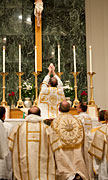 On Wednesday, March 7, 2012, Archbishop J. Peter Sartain of Seattle was hosted by the Priestly Fraternity of Saint Peter parish of the North American Martyrs for a pastoral visit to commemorate the feast of St. Thomas Aquinas.
On Wednesday, March 7, 2012, Archbishop J. Peter Sartain of Seattle was hosted by the Priestly Fraternity of Saint Peter parish of the North American Martyrs for a pastoral visit to commemorate the feast of St. Thomas Aquinas.
Archbishop Sartain assisted from the throne for the Solemn High Mass offered by Fr. Gerard Saguto, FSSP, the administrator of North American Martyrs. Also assisting at the Mass were FSSP priests Fr. Simon Harkins, Fr. Gregory Pendergraft, Fr. Dan Geddes, and Fr. Matthew McNeely, along with Fr. Paul Pluth (archdiocese of Seattle) and Fr. Boniface Willard, O.P.
More than 600 souls were in attendance for the Mass, and the Fraternity extends its warm thanks for the Archbishop’s visit, and assistance in honoring the Angelic Doctor.
North American Martyrs currently offers the Mass and Sacraments at St. Alphonsus Church in northwest Seattle. (northamericanmartyrs.org | Full Picture Gallery)
March 23, 2012

